What are green roofs?
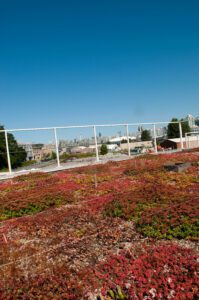
Green roofs are engineered roofing systems incorporating the use of vegetation that make environmental, economic, and social contributions to urban areas. The Green Roof Research Facility focuses on extensive green roofs.
Green roofs have limited impact in short span construction. The weight of a 3″ green roof is approximately equal to gravel ballast use in inverted roof systems. For long span construction, load considerations may require structural engineering.
There are three types of green roofs:
1. Extensive Green Roofs – designed for environmental solutions
- 3- 6″ of light weight growing medium.
- low-maintenance ground-cover plants.
- ideal for large flat-roof buildings and apartments.
- suitable for low-sloped residential roofs and retrofits.
- desert grasses and succulent plants.
- after one year, they do not require watering.
- annual spring weeding of tree seedlings & weeds – brought in by birds and wind.

2. Intensive Green Roofs – also known as rooftop gardens
- 8-12 inches, or more, of growing medium.
- fully landscaped roof top garden.
- require regular maintenance -similar to an at-grade garden.
- diverse plants and trees can be planted (avoid plants with invasive root systems).
- walkways, railings and lighting.
- parks, playgrounds or vegetable gardens are possible
3. Semi-intensive Green Roofs – elements of both extensive and intensive systems
- Semi-intensive roofs, combinations of both extensive and intensive green roofs, are typically adopted to harness both the environmental benefits of a green roof, as well as a diverse garden within a manageable maintenance budget.
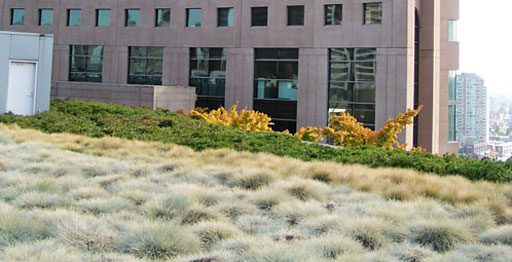
Planting the rooftops of urbanized areas brings many benefits to public, private, economic and social sectors, as well as to the local and global environments. While all green roofs have similar functions, each installation is unique, so technical performance will vary by region, climate, building and green roof type and design. The benefits described below can be achieved by virtually all green roof systems and designs.
Benefit: Green roofs reduce stormwater runoff
During heavy or continuous rain, runoff can overwhelm stormwater infrastructure and potentially damage waterways and fish habitat.
- Green roof growing media retain rainwater and, together with plants, return a portion of this water to the atmosphere through evaporation and transpiration (evapotranspiration).
- Stormwater that does leave the roof is delayed and reduced in volume.
- Stormwater that runs off a green roof is cleaner than runoff from a conventional roof.
- Retention and delay of runoff eases stress on stormwater infrastructure and sewers.
- Cost savings from decentralized stormwater mitigation reduces the need to expand or renovate related infrastructure.
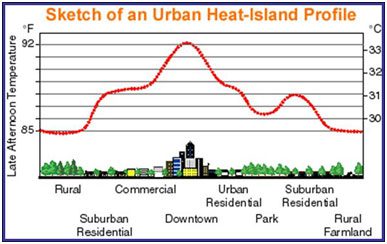
Benefit: Green roofs are energy efficient
Green roofs reduce the heat flux through the roof, and less energy for cooling or heating can lead to significant cost savings. Shading the outer surface of the building envelope has been shown to be more effective than internal insulation.
- In summer, the green roof protects the building from direct solar heat.
- In winter, the green roof minimizes heat loss through added insulation on the roof.
- Energy conservation translates into fewer greenhouse gas emissions.
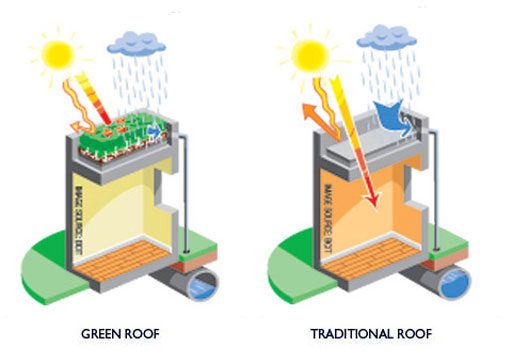
Benefit: Green roofs improve air quality
Plant leaves trap dust particles from the air, and evapotranspiration cools ambient temperatures.
- Less ground level ozone + less heat = less smog.
- Reduced Urban Heat Island profile.
- Less need for health care services result in societal cost savings.
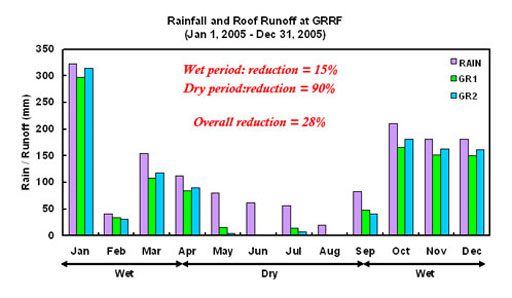
Benefit: Green roofs can serve as habitat
As undisturbed areas, rooftops can serve as refuge for creatures that struggle for survival. Ground-nesting birds, such as Killdeer, use green roofs for nesting and raising their young.
- Vegetated rooftop habitats can serve as stepping stones, to create corridors connecting other patches (roofscape or at grade) across an urban sea to natural habitats beyond the city.
- Natural habitats can serve as templates for green roofs designed for biodiversity.
- Low maintenance green roofs can be designed to serve as refuge for species such as ground-nesting birds.
Benefit: Green roofs last longer
Green roofs cover the waterproofing membrane, protecting it from UV rays and extreme daily temperature fluctuations. This protection extends the lifespan of the waterproofing twice as long as conventional roofing, meaning that membranes under green roofs last twice as long as those on traditional roofs.
- Reduced material waste from re-roofing.
- Less frequent re-roofing, less costs over time.
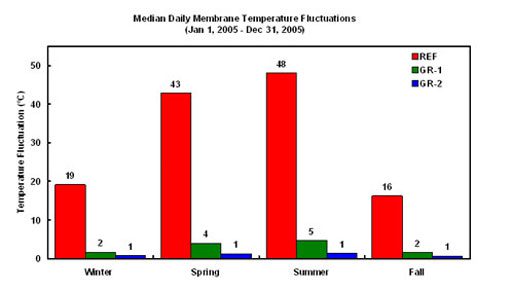
Benefit: Life cycle costs are competitive
The initial installation cost of a green roof is more than a traditional roof; however, the life cycle cost is competitive. Try out Green Roofs for Healthy Cities’ Green Save Calculator [PDF].
Benefit: Green roofs provide ‘extra’ space
Green roofs make the most of unused space within the increasing density of our cities. Rooftops can be developed into social and recreational spaces and used for urban agriculture.
- Amenity space for day care, meetings, and recreation.
- Improved aesthetic views for neighbours in adjacent buildings.
- Improved worker productivity and creativity.
- Potential to enhance urban food security through rooftop gardening and food production.
Benefit: Job creation
A new industry represents a new market that will provide employment opportunities:
- Supply and manufacture of roofing membranes and root repellent layers, drainage layers, landscaping cloth, curbs, irrigation systems and other specialty products.
- Supply and manufacture of substrate, light-weight soils and amendments, plants.
- Design and engineering professionals, contractors and landscapers; and companies supplying maintenance contracts.
Other Benefits
Green roofs offer so many benefits, it’s hard to imagine listing them all. Here are a few more:
- By improving energy efficiency and addressing the “Urban Heat Island Effect”, we can better prepared and adapted to climate change.
- Hospital patients with natural views require less medication and attention and may be discharged sooner.
- Opportunities to recycle aggregate and compost.
- Potential for faster approval process for new projects (e.g. Chicago).
- Potential for reduced stormwater/ wastewater charges from municipality or utility.
- Potential to reduce the size of stormwater management ponds or cisterns, resulting in cost savings.
- Potential for grants related to energy efficiency and/ or green roofs.
- Potential for density bonusing/ larger floor area ratio (e.g. Portland OR).
- Potential to score more than 7 credits under the US and Canadian Green Building Council LEED certification system.
- Potential for satisfying minimum parkland / green space set aside, requirements.
Extensive green roofs are lightweight adaptations of sod roofs, like those found in Scandinavia during the Viking and Middle Ages. In fact, reconstructions of Norse sod houses dating from 1000 A.D. are protected as a UNESCO World Heritage Site in L’Anse aux Meadows, Newfoundland, and commemorate the earliest known European settlement in North America. Green roofs are an old idea!
During the oil crisis of the 1970s, West Germany explored lightweight adaptations of sod roofs for the purpose of energy conservation. Since that time, extensive green roofs have been lauded for their many benefits as cost-effective solutions for urban environmental problems. By 2005, an estimated 13 million m2 roof area in Germany was covered with plants.
As cities in other parts of the world learn about the benefits of extensive green roofs, adoption of this lightweight technology has been growing worldwide. In North America, the industry association Green Roofs for Healthy Cities was founded in 1999, and has organized annual green roof conferences every year since 2003. Cities that have adopted programs and/ or policies which promote extensive green roofs include Chicago, New York, Toronto, Portland, and Washington D.C.
Extensive green roofs were originally developed, tested and evaluated in the temperate climate of western Europe, which is typified by warm summers with frequent rains and cold winters. Eastern North America shares a relatively similar climate, if somewhat more extreme. The climate of the Pacific North-West, however, is dramatically different from both of these regions. Here, our summers are hot and dry, and our winters mild and wet.
In Vancouver and within the greater Georgia Basin and Puget Sound bioregion (ranging from Whistler in the north to Puget Sound in the south), population growth is yielding problematic runoff issues and unsustainable rates of energy consumption. In 1960 the region was home to 2.6 million people living and working in an area connected by sea, rivers, forest and mountains. By 1996, the population had risen to over 6 million, and by 2020 there may be an additional 3 to 5 million people. Fortunately, people are beginning to recognize that green roof technology can help address the problems associated with impervious urban growth. (Source: GVRD Livable Region Strategic Plan (1999))
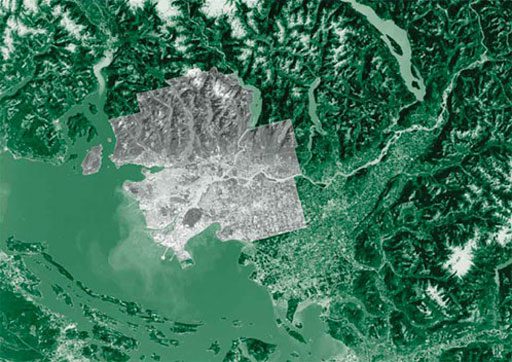
Green roofs and photovoltaic panels are complementary technologies that improve each other’s performance. The PV functions more efficiently thanks to the cooler ambient temperatures above the green roof, and the green roof benefits from the areas of shade. Read more about the synergistic relationship between green roofs and solar panels here:
Appl, R. and W. Ansel. 2004. Future oriented and sustainable green roofs in Germany [PDF]. In: Proceedings from the 2nd annual Greening Rooftops for Sustainable Communities conference, awards and trade show. Portland. OR. Green Roofs for Healthy Cities.
Koehler, M. et al. 2002. Photovoltaic panels on greened roofs: Positive interaction between two elements of sustainable architecture [PDF]. In: Proceedings from Rio 02-World Climate & Energy Event.
The first step in considering a green roof for an existing building is to have its structural loading capacity assessed by a structural engineer. With this figure, which must include both live and dead loads, you can then decide what kind of green roof system the roof will support.
Depending on the system used, extensive green roofs weigh between 60 and 240 kg/ m2 (Kolb & Schwarz, 1999). If you wish to retrofit a ballast roof, the weight of the ballast may match the loading required for an extensive green roof. The structural engineer will provide you with this important information.
Reference:
Kolb, W. and T. Schwarz. 1999. Dachbegrünung: Intensiv und extensive. Eugen Ulmer, Stuttgart.